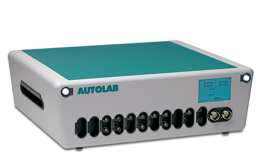Electrochimistry

Potentiostats - Galvanostats
The ELAN team owns a dozen of de potentiostats / galvanostats for the investigation of charge transfer studies at both solid-liquid and liquid-liquid interfaces using a wide range of electrochemical techniques (voltammetry, amperometry, potentiometry, electrochemical impedance spectroscopy, scanning electrochemical microscopy). Low-current (pA), current booster (20 A) and fast scan (up to 125 kV / s) modules are available on some of our instruments.

High frequency impedance
Thanks to the development of a specific measurement cell (operating in closed reactor or in hydrodynamic conditions), this technique allows us to monitor physicochemical processes occurring at solid/liquid interfaces. It is possible to follow adsorption phenomena (on a conductive or insulating substrate), ion exchange, phase changes (example of dissolution - precipitation of calcium phosphate into hydroxyapatite for medical applications). The most suitable frequency range for monitoring these processes is 0.4 - 100 MHz.

Electrochemical quartz crystal microbalance
The electrochemical quartz crystal microbalance is designed to measure mass variations on the surface of a gold electrode. This allows the kinetic and quantitative monitoring of adsorption/desorption phenomena and electrodeposition/corrosion processes with a sensitivity of the order of ng/cm².

Raman spectroelectrochemistry
The Raman spectro-electrochemistry set-up combines Raman spectroscopy measurements (532 nm) with electrochemical measurements using a potentiostat. The laser is focused on the samples at the solid-liquid or liquid-liquid interfaces using an optical microscope, equipped with an immersion objective (x 60) and the Raman signal is collected by spectrophotometer.

Spectro-électrochimistry UV-vis
A UV-vis spectrophotometer (200 - 1100 nm) is coupled to a potentiostat / galvanostat for the spectro-electrochemical analysis of samples at the solid-liquid and liquid-liquid interface. The light source is a deuterium-halogen lamp (200 – 2500 nm).
Chemical Analysis

ICP-MS
The presence of trace elements in environmental liquid samples is detected (> 10 ppb) using a mass spectrometer. Speciation of elements is possible thanks to coupling with ion chromatography. This ICP-MS allows analyzes to be carried out in saline and hydrofluoric acid environments. It is also equipped with a fast acquisition module for the determination of nanoparticle size (> 20 nm) in aqueous suspension.

Ion Chromatography
We own two ion chromatographs with conductivity detection for the analysis of cationic and anionic species of mineral or organic origin present in our aqueous phases. The ion chromatograph dedicated to the anion analysis is equipped with double chemical and CO2 suppression, a neutralizer for the elimination of interfering cations from the sample and a device allowing the creation of an elution gradient. The CI - ICP MS coupling is dedicated to analysis by species speciation (case of simultaneous iron(II) and iron(III) analysis).

HPLC-UV
A high-performance liquid chromatography (HPLC) apparatus with high-pressure gradient and UV-visible detection is used for chemical analysis in reverse phase liquid chromatography (RPLC). Samples are injected manually.

Stopped-flow
The ELAN team owns a Stopped-flow instrument for the study of reaction kinetics (10 ms < t < 10 s) in micro-heterogeneous solutions and media, adsorption in colloidal suspensions or even formation of nanoparticles. Spectrophotometric detection is complemented by fast conductivity detection.

Microwave digestion
The microwave digestion system is equipped with 12 PTFE reactors (50 mL) and can reach 20 bars and 200 °C for the dissolution and mineralization of samples for their chemical analysis.
Development and characterisation

3D printing
The ELAN team owns two PRUSA FDM (Fused Deposition Modelling) 3D printers. One of them is equipped with an accessory allowing you to print up to 5 different materials (or colors) automatically. Printers accept most 3D design formats (.stl). PETG, PVA, Nylon filaments and its composites (eg. CNT) are used. The precision is of the order of 100 to 200 µm. The Asiga Pico2 HD 3D printer is based on the STL technique. Small structures (less than 5cm × 3cm) can be printed by a photosensitive resin which solidifies under UV radiation (385 nm). The lateral accuracy is 27 µm and the vertical accuracy is 1 µm.

Profilometer
The Dektak XT profilometer (Brüker) is dedicated to the analysis of the surface roughness and/or the thickness of films and coatings. It is equipped with a digital camera to view the sample which is placed on a 10 cm × 10 cm platform. The probe is 2.5 µm in diameter. Vertical measurements can achieve a repeatability of 0.4 nm.

Micro-mechanical analysis
The micro-mechanical analysis platform is equipped with a precise 3D motion controller and a capacitive force sensor. Depending on the model, the sensor can measure forces from 1 nN to 200 mN with a spherical (25 µm radius) or square (50 µm × 50 µm) contact of the sample. It is thus possible to measure mechanical properties (elasticity, Young's modulus, etc.) with micrometric spatial resolution. By scanning the sensor, 3D mechanical and topographical maps can also be recorded.
